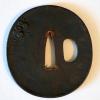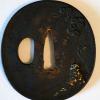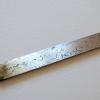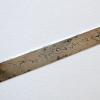Hi everyone,
I just wanted to share my first Japanese blade purchase. I have been looking for the right occasion for quite a while, always wondered if it was the right sword (mainly being ancient) at the right price according to my means.
Anyways, just bought this one from an old weapon collector.
The blade is in average condition. It is signed AMAKUNI thanks to the excellent database of this website.
Any thoughts are appreciated, especially on dating the blade and the components of this sword (tsuba, menuki, saya, tsuka...)
Here are the dimensions that might be needed to perform a proper dating.
nagasa: 57,7 cm
moto-kasane: 6,45 mm
saki-kasane: 4 mm
moto-haba: 3 cm
saki-haba: 1,8 cm
sori: 2,5 cm
Many thanks in advance.






Amakuni
Hi Louis,
And welcome to Nihonto Club! Well I have some good and some not so good news for you.
Good
It looks like a genuine old Japanese sword (100% not a modern fake).
Not so good
Tsuba, fuchi and even nakago appear to be cleaned from rust with some abrasive material. Even though the nakago is not so bad, it significantly reduces the value of its mounts and fittings.
To have a sword signed Amakuni is a little bit like to have a painting signed 'Da Vinci'. Amakuni was a legendary smith, the father of Japanese sword, who lived in ancient times. Your sword is not ancient which leaves 2 possibilities:
Regards,
Stan
Hi Stan, thanks a lot for
Hi Stan,
thanks a lot for your comments. Well, those are globally good news for me ;-)
Genuineness was really my concern. I am relieved even if it is not a perfect sword. For a 1st plunge into this new world, this is quite encouraging.
I have seen the several Amakunis registered on the Swordsmith DB, there still might be others from other centuries.
With regards to polish the blade, I imagine this has to be done by professional hands only. Would it bring any interest/value (especially if this operation might be costly I imagine) in this piece which is in used condition?
Are there any ways to restore the Tsuba and nakago to a more decent condition? Is the saya original to the blade? The menukis are also worn but I like the wolves (or tigers) depicted.
Kind regards
Louis.
Forgot to mention. Is there
Forgot to mention.
Is there any way to date the blade with the combination of its measurements?
Thanks.
polish
I see that it is signed "katana-mei", not "tachi-mei". This might be an important clue, but I don't know enough to understand that clue without a lot of research.
I would perhaps expect an Amakuni tribute or gimei to be tachi-mei, but I don't know...
Polishing:
Absolutely, any polishing/restoration work must be done by a properly-trained professional. Almost all of the qualified togishi (polishers) are in Japan. There are maybe 2 Westerners that are qualified.
Polishing is expensive - I think it would cost $2000-3000 for a blade like this. If the blade turns out to be poor quality, or has a serious flaw, then the money is wasted.
IF the blade is good and the polish successful, THEN it will increase the value, but it is impossible to predict how much.
I DO NOT recommend using polishing as a way to increase value.
The correct reason to polish it is to learn more about it, if you can afford to do so.
My worry would be that the sandpaper damage is too serious to be fixed. In particular, the damage to the nakago (tang) will never be fixed (the original rust/patina cannot be put back).
Pete
menuki
I think the menuki are "shishi" (mythical lion).
Tsuba and fuchi:
You could consider attempting to "fix" the patina with chemicals.
It would make them look better, but would NOT restore the value (in my opinion).
Currently, their value is probably low, because of the sandpaper damage, so perhaps there is "nothing to lose" (my opinion).
Do NOT attempt to "fix" anything on the blade.
Pete
Thanks Pete for your precious
Thanks Pete for your precious comments.
I will not attempt anything on this sword, I swear! It will stay as is with its special meaning for me, as the first collected of my future ;-) collection.
Kind regards,
Louis.
PS: the menukis are definitely not Shishis, those are tigers often found in netsuke (I collect netsukes and okimonos)
Amakuni
Louis,
I listed all known Amakuni from Nihonto Meikan. This means that finding an unlisted Amakuni is not impossible, but chances are very slim.
Regards,
Stan
Bronzing
Hi,
I have followed some recommandations.
I have used some gun bronzing product (very easy to do!) on the tsuba and fukichi (and also on the nagako where the rust was gone, very very gently!). I am quite happy with the result.
For the blade I did nothing peculiar apart from buying a japanese blade care kit to gently polish (blanc de meudon powder I guess) and oil.
Here are the results.
New purchase(s)
Hi,
I just came by the opportunity to buy the following 2 blades:
A tanto with engravings And a wakizashi which I can't get the blade out...
Please see the images I uploaded in the first post of the thread.
What are your thoughts in terms of period, quality of the attributes and those markings on the blades?
Many thanks.
Louis.
Hi Louis, I can't say much
Hi Louis,
I can't say much about the blades because they are out of polish. They may be decent or may be poor quality - only professional polishing will tell. The shape of the first one (wakizashi?) is average-to-poor. The tanto looks fine.
The fittings are ok, I'd say typical late Edo. It will require a fair bit of restoration to put these swords in good order.
Regards,
Stan
Thanks Stan. I managed to
Thanks Stan.
I managed to take the blade out of the tsuka of the waki:
http://i60.tinypic.com/50r4hv.jpg
No signature... The engravings are definitely done to hide some imperfections of the blade (at least on one side I could clearly see it)
And I also measured the Tanto, might be a small wakizashi, no?
http://i60.tinypic.com/2q9c7fb.jpg
Best regards,
Louis.
tanto
I would call it tanto.
However, a note on terminology:
Some of the words are katana, tachi, wakizashi, tanto, aikuchi, nodachi, daito, shoto, ken, tsurugi, etc.
None of these terms are "absolute".
Most of the terms describe how the blade is worn or used, NOT so much the length or style of the blade itself.
A lot of western collectors are obsessed with the "rule" that less than 12" is a tanto, and less than 24" is a wakizashi. But it's not a good rule.
If you are a samurai wearing two swords, then you can call the shorter one a wakizashi - it doesn't matter how long it is. You may call the longer one a katana. Or, you may refer to them as daito and shoto (big sword and little sword).
I have a small tanto. But I call it an aikuchi because the mountings do not include a tsuba.
Pete